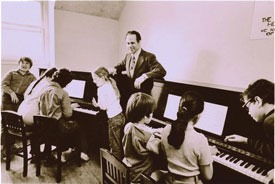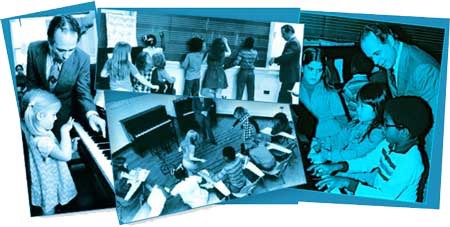
One of Robert Pace’s many gifts as a teacher was his ability to inspire students to learn by continuously searching out connections between one thing and the other. He integrated the teaching of repertoire with the teaching of theory, improvisation, technique, sightreading, multiple tonalities, and a musically sensitive performance. He coordinated the learning experiences of a diversity of students, teaching many at one time. More than that, he perceived the possibilities for teaching students interactively with one another. He tied peer teaching with conceptual learning. And, along with his own ideas, he creatively adapted for piano teaching, the philosophies of Jerome Bruner, Howard Gardner, Abraham Maslow, and many other learning theorists, neurologists, and thinkers.
No wonder he often peppered his conversation with some form of the word “multi.” He spoke of “multi-key,” “multi-level,” “multi-purpose,” and a multiplicity of other ideas. “Multi-facetedness” was a hallmark of his teaching philosophy—a reservoir of elements, many in number, but all very much interrelated.

His many pedagogical insights could each have stood alone as a significant chapter in the teaching of music. But he envisioned coordinating all of these elements so that they could be taught together as mutually reinforcing ingredients of musicianship. “Comprehensive Musicianship” was the term he used to denote his unified curriculum built upon peer teaching, conceptual learning, inter-related repertoire, technique, multiple tonalities, creative activities, theory, analysis, musicianship, and assorted educational philosophies.
- Cynthia Pace -
(Adapted from MTNA Presentation, “Robert Pace, Dynamic Music Educator,” by Cynthia Pace, March 2011)